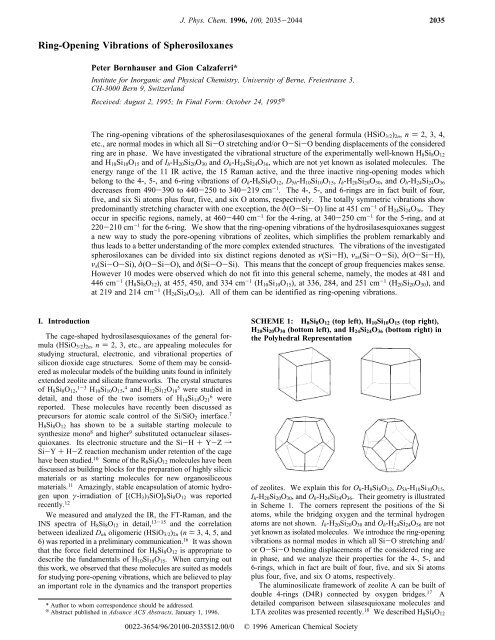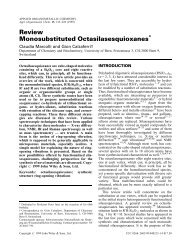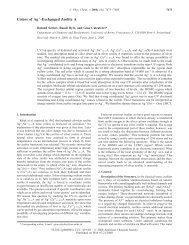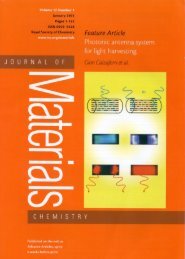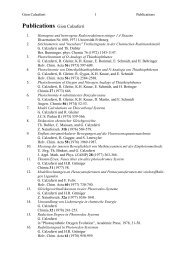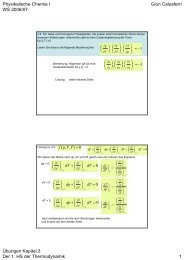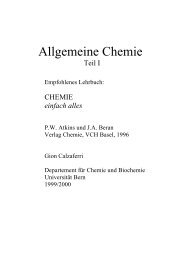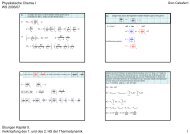Ring-Opening Vibrations of Spherosiloxanes - American Chemical ...
Ring-Opening Vibrations of Spherosiloxanes - American Chemical ...
Ring-Opening Vibrations of Spherosiloxanes - American Chemical ...
Create successful ePaper yourself
Turn your PDF publications into a flip-book with our unique Google optimized e-Paper software.
<strong>Ring</strong>-<strong>Opening</strong> <strong>Vibrations</strong> <strong>of</strong> <strong>Spherosiloxanes</strong><br />
I. Introduction<br />
Peter Bornhauser and Gion Calzaferri*<br />
Institute for Inorganic and Physical Chemistry, UniVersity <strong>of</strong> Berne, Freiestrasse 3,<br />
CH-3000 Bern 9, Switzerland<br />
ReceiVed: August 2, 1995; In Final Form: October 24, 1995 X<br />
The ring-opening vibrations <strong>of</strong> the spherosilasesquioxanes <strong>of</strong> the general formula (HSiO3/2)2n, n ) 2, 3, 4,<br />
etc., are normal modes in which all Si-O stretching and/or O-Si-O bending displacements <strong>of</strong> the considered<br />
ring are in phase. We have investigated the vibrational structure <strong>of</strong> the experimentally well-known H8Si8O12<br />
and H10Si10O15 and <strong>of</strong> Ih-H20Si20O30 and Oh-H24Si24O36, which are not yet known as isolated molecules. The<br />
energy range <strong>of</strong> the 11 IR active, the 15 Raman active, and the three inactive ring-opening modes which<br />
belong to the 4-, 5-, and 6-ring vibrations <strong>of</strong> Oh-H8Si8O12, D5h-H10Si10O15, Ih-H20Si20O30, and Oh-H24Si24O36<br />
decreases from 490-390 to 440-250 to 340-219 cm -1 . The 4-, 5-, and 6-rings are in fact built <strong>of</strong> four,<br />
five, and six Si atoms plus four, five, and six O atoms, respectively. The totally symmetric vibrations show<br />
predominantly stretching character with one exception, the δ(O-Si-O) line at 451 cm -1 <strong>of</strong> H24Si24O36. They<br />
occur in specific regions, namely, at 460-440 cm -1 for the 4-ring, at 340-250 cm -1 for the 5-ring, and at<br />
220-210 cm -1 for the 6-ring. We show that the ring-opening vibrations <strong>of</strong> the hydrosilasesquioxanes suggest<br />
a new way to study the pore-opening vibrations <strong>of</strong> zeolites, which simplifies the problem remarkably and<br />
thus leads to a better understanding <strong>of</strong> the more complex extended structures. The vibrations <strong>of</strong> the investigated<br />
spherosiloxanes can be divided into six distinct regions denoted as ν(Si-H), νas(Si-O-Si), δ(O-Si-H),<br />
νs(Si-O-Si), δ(O-Si-O), and δ(Si-O-Si). This means that the concept <strong>of</strong> group frequencies makes sense.<br />
However 10 modes were observed which do not fit into this general scheme, namely, the modes at 481 and<br />
446 cm -1 (H8Si8O12), at 455, 450, and 334 cm -1 (H10Si10O15), at 336, 284, and 251 cm -1 (H20Si20O30), and<br />
at 219 and 214 cm -1 (H24Si24O36). All <strong>of</strong> them can be identified as ring-opening vibrations.<br />
The cage-shaped hydrosilasesquioxanes <strong>of</strong> the general formula<br />
(HSiO3/2)2n, n ) 2, 3, etc., are appealing molecules for<br />
studying structural, electronic, and vibrational properties <strong>of</strong><br />
silicon dioxide cage structures. Some <strong>of</strong> them may be considered<br />
as molecular models <strong>of</strong> the building units found in infinitely<br />
extended zeolite and silicate frameworks. The crystal structures<br />
<strong>of</strong> H8Si8O12, 1-3 H10Si10O15, 4 and H12Si12O18 5 were studied in<br />
detail, and those <strong>of</strong> the two isomers <strong>of</strong> H14Si14O21 6 were<br />
reported. These molecules have recently been discussed as<br />
precursors for atomic scale control <strong>of</strong> the Si/SiO2 interface. 7<br />
H8Si8O12 has shown to be a suitable starting molecule to<br />
synthesize mono 8 and higher 9 substituted octanuclear silasesquioxanes.<br />
Its electronic structure and the Si-H + Y-Z f<br />
Si-Y + H-Z reaction mechanism under retention <strong>of</strong> the cage<br />
have been studied. 10 Some <strong>of</strong> the R8Si8O12 molecules have been<br />
discussed as building blocks for the preparation <strong>of</strong> highly silicic<br />
materials or as starting molecules for new organosiliceous<br />
materials. 11 Amazingly, stable encapsulation <strong>of</strong> atomic hydrogen<br />
upon γ-irradiation <strong>of</strong> [(CH3)3SiO]8Si8O12 was reported<br />
recently. 12<br />
We measured and analyzed the IR, the FT-Raman, and the<br />
INS spectra <strong>of</strong> H8Si8O12 in detail, 13-15 and the correlation<br />
between idealized Dnh oligomeric (HSiO3/2)2n (n ) 3, 4, 5, and<br />
6) was reported in a preliminary communication. 16 It was shown<br />
that the force field determined for H8Si8O12 is appropriate to<br />
describe the fundamentals <strong>of</strong> H10Si10O15. When carrying out<br />
this work, we observed that these molecules are suited as models<br />
for studying pore-opening vibrations, which are believed to play<br />
an important role in the dynamics and the transport properties<br />
* Author to whom correspondence should be addressed.<br />
X Abstract published in AdVance ACS Abstracts, January 1, 1996.<br />
J. Phys. Chem. 1996, 100, 2035-2044<br />
2035<br />
SCHEME 1: H8Si8O12 (top left), H10Si10O15 (top right),<br />
H20Si20O30 (bottom left), and H24Si24O36 (bottom right) in<br />
the Polyhedral Representation<br />
<strong>of</strong> zeolites. We explain this for Oh-H8Si8O12, D5h-H10Si10O15,<br />
Ih-H20Si20O30, and Oh-H24Si24O36. Their geometry is illustrated<br />
in Scheme 1. The corners represent the positions <strong>of</strong> the Si<br />
atoms, while the bridging oxygen and the terminal hydrogen<br />
atoms are not shown. Ih-H20Si20O30 and Oh-H24Si24O36 are not<br />
yet known as isolated molecules. We introduce the ring-opening<br />
vibrations as normal modes in which all Si-O stretching and/<br />
or O-Si-O bending displacements <strong>of</strong> the considered ring are<br />
in phase, and we analyze their properties for the 4-, 5-, and<br />
6-rings, which in fact are built <strong>of</strong> four, five, and six Si atoms<br />
plus four, five, and six O atoms, respectively.<br />
The aluminosilicate framework <strong>of</strong> zeolite A can be built <strong>of</strong><br />
double 4-rings (D4R) connected by oxygen bridges. 17 A<br />
detailed comparison between silasesquioxane molecules and<br />
LTA zeolites was presented recently. 18 We described H8Si8O12<br />
0022-3654/96/20100-2035$12.00/0 © 1996 <strong>American</strong> <strong>Chemical</strong> Society
2036 J. Phys. Chem., Vol. 100, No. 6, 1996 Bornhauser and Calzaferri<br />
SCHEME 2: Relation between the Structure <strong>of</strong> Zeolite<br />
A and H8Si8O12 (right) and H24Si24O36 (left)<br />
as a model for the vibrational structure <strong>of</strong> zeolite A. 14 A<br />
consequence <strong>of</strong> these ideas is shown in Scheme 2, in which the<br />
hydrosilasesquioxanes H8Si8O12 and H24Si24O36 are related to<br />
the structure <strong>of</strong> zeolite A. Since H24Si24O36 bears the structure<br />
<strong>of</strong> the sodalite cage, it may be used as a link to the many zeolites<br />
in which this structure is present. 19 A similar link to clathrasils 20<br />
can be tried via the H20Si20O30. Several attempts have been<br />
made to assign the observed vibrational modes to specific local<br />
structural features <strong>of</strong> zeolites and especially to pore-opening<br />
vibrations. 21-27 We now show that the ring-opening vibrations<br />
<strong>of</strong> the hydrosilasesquioxanes suggest a new way to study the<br />
pore-opening vibrations <strong>of</strong> zeolites. This approach simplifies<br />
the problem remarkably and thus leads to a better understanding<br />
<strong>of</strong> the more complex extended structures.<br />
II. Experimental Section<br />
The normal mode calculations were performed by the Wilson<br />
GF matrix method 28 using the computer program package<br />
QCMP067. 29 The point charge model for describing molecular<br />
dipole moments was used to calculate relative infrared intensities.<br />
The atom charges, Si ) +0.498, O ) -0.305, and H )<br />
-0.040, were obtained from an extended-Hückel molecular<br />
orbital calculation 30 <strong>of</strong> H8Si8O12 with the parameters reported<br />
in ref 8b. The bands <strong>of</strong> the calculated IR spectra were generated<br />
using a 1:1 mixture <strong>of</strong> a Lorentzian and a Gaussian curve which<br />
were adapted to the experimental bandwidths. The structure<br />
and the definition <strong>of</strong> the internal coordinates <strong>of</strong> the (HSiO3/2)2n<br />
(n ) 4, 5, 10, and 12) are illustrated in Schemes 3S and 4S.<br />
For details we refer to ref 14. This definition <strong>of</strong> the internal<br />
coordinates is consistent with the usual conventions. It is<br />
applicable to all spherosiloxanes and results in 24 Si-H and<br />
TABLE 1: Bond Lengths (Å) and Bond Angles (deg) Used<br />
for H8Si8O12 and H10Si10O15<br />
internal coordinate H8Si8O12 H10Si10O15<br />
R(Si-H) 1.48 1.48<br />
r(Si-O) 1.62 1.61<br />
s(Si-O) 1.60<br />
R(O-Si-H) 109.5 109.5<br />
(O-Si-O) 109.5 109.5<br />
γ(O-Si-H) 109.5<br />
δ(O-Si-O) 109.5<br />
Φ(Si-O-Si) 148.4 150.5<br />
Ψ(Si-O-Si) 156.1<br />
72 Si-O bond-stretching and in 72 O-Si-H, 72 O-Si-O,<br />
and 36 Si-O-Si valence angle bending coordinates for H24-<br />
Si24O36 with F and G matrices <strong>of</strong> dimension 276. The<br />
corresponding dimension <strong>of</strong> the F and G matrices for H20Si20O30<br />
is 230. The bond lengths and bond angles <strong>of</strong> Oh-H8Si8O12 and<br />
<strong>of</strong> D5h-H10Si10O15 used in this study are reported in Table 1.<br />
The vibrational analysis <strong>of</strong> all (HSiO3/2)2n oligomers was<br />
performed using the modified general valence force field<br />
determined for H8Si8O12. 14 According to Table 5 <strong>of</strong> ref 14,<br />
not all internal force constants are linearly independent because<br />
<strong>of</strong> symmetry. Three <strong>of</strong> the 13 <strong>of</strong>f-diagonal elements must<br />
therefore be eliminated. We have done this by setting fRR, f,<br />
and f′rR equal to 0 when carrying out the calculations. This<br />
arbitrary choice does not influence any <strong>of</strong> our results. The<br />
molecules H8Si8O12, D8Si8O12, H10Si10O15, and D10Si10O15 were<br />
prepared and purified as described in refs 9e and 31-33, and<br />
their IR and Raman spectra were measured as described in refs<br />
14, 33, and 34.<br />
III. Correlation <strong>of</strong> the Vibrational Spectra <strong>of</strong> H8Si8O12<br />
and H10Si10O15<br />
Structure and Irreducible Representations. H8Si8O12 and<br />
H10Si10O15 single crystals show S6 and C2 molecular symmetry,<br />
respectively. 2-4 The deviation from the “ideal” Oh and D5h<br />
symmetry is small, and spectra measured in solution are fully<br />
compatible with Oh and D5h symmetry, respectively. It is<br />
therefore convenient and useful to describe the vibrations <strong>of</strong><br />
these molecules within the Oh and the D5h point groups,<br />
respectively, and to discuss deviations <strong>of</strong> this symmetry<br />
separately; see refs 13-15. On this basis the 78 vibrational<br />
degrees <strong>of</strong> freedom <strong>of</strong> H8Si8O12 and the 99 ones <strong>of</strong> H10Si10O15<br />
are divided among the irreducible representations as follows<br />
(R ) Raman active, IR ) infrared active, in ) inactive).<br />
O h -H 8 Si 8 O 12 :<br />
Γ vib ) 3A 1g (R) + A 2g (in) + 4E g (R) + 3T 1g (in) +<br />
6T 2g (R) + 3A 2u (in) + 3E u (in) + 6T 1u (IR) + 4T 2u (in) (1)<br />
D 5h -H 10 Si 10 O 15 :<br />
Γ vib ) 7A 1 ′(R) + 3A 2 ′(in) + 10E 1 ′(IR) + 11E 2 ′(R) +<br />
3A 1 ′′(in) + 6A 2 ′′(IR) + 9E 1 ′′(R) + 10E 2 ′′(in) (2)<br />
From this follows that the IR spectrum <strong>of</strong> Oh-H8Si8O12 consists<br />
<strong>of</strong> six and that <strong>of</strong> D5h-H10Si10O15 <strong>of</strong> 16 fundamentals. The<br />
Raman spectrum <strong>of</strong> Oh-H8Si8O12 consists <strong>of</strong> 13 fundamentals,<br />
whereas 27 lines are expected for D5h-H10Si10O15.<br />
Dnh-D(n+1)h Correlation. We consider the members <strong>of</strong> the<br />
oligomeric (HSiO3/2)2n molecules as a series <strong>of</strong> double-ring units<br />
with Dnh symmetry. This is illustrated in Figure 1. Since D4h<br />
is a subgroup <strong>of</strong> the Oh point group, we apply a small distortion<br />
to the Oh-H8Si8O12 so that it fits into this series. The correlation
<strong>Ring</strong>-<strong>Opening</strong> <strong>Vibrations</strong> <strong>of</strong> <strong>Spherosiloxanes</strong> J. Phys. Chem., Vol. 100, No. 6, 1996 2037<br />
Figure 1. Oligomeric (HSiO3/2)2n (n ) 3, 4, 5, and 6) spherosiloxanes<br />
in the polyhedral representation as double-ring units.<br />
for this symmetry lowering is straightforward. 35 The irreducible<br />
representations for the fundamentals <strong>of</strong> the four structures are<br />
as follows:<br />
D3h ΓT6H ) 7A1 ′ + 3A2 ′ + 10E′ + 3A1 ′′ + 6A2 ′′ + 9E′′<br />
D4h ΓT8H ) 7A1g + 3A2g + 5B1g + 6B2g + 9Eg + 3A1u +<br />
6A 2u + 6B 1u + 4B 2u + 10E u<br />
D5h ΓT10 H ) 7A1 ′ + 3A2 ′ + 10E1 ′ + 11E2 ′ + 3A1 ′′ + 6A2 ′′ +<br />
9E1 ′′ + 10E2 ′′ (3)<br />
D6h ΓT12 H ) 7A1g + 3A2g + 4B1g + 6B2g + 9E1g + 11E2g +<br />
3A 1u + 6A 2u + 6B 1u + 5B 2u + 10E 1u + 10E 2u<br />
Each point group Dnh correlates with D∞h as reported for n )<br />
3, 4, 5, and 6 in Table 2, in which the number <strong>of</strong> symmetry<br />
species is included. The horizontal lines separate the irreducible<br />
representations relevant for the investigated molecules from the<br />
others. Each row shows an equal number <strong>of</strong> irreducible<br />
representations for all molecules. The E2g and E2u start to play<br />
a role at D4h. The E3g and E3u start at D6h. This result allows<br />
us to correlate the fundamentals row by row. The group<br />
theoretical correlation between neighboring Dnh point groups<br />
was obtained by considering the maximum common symmetry<br />
elements <strong>of</strong> the two groups and the activity <strong>of</strong> the vibrations. 36<br />
Symmetry lowering from Oh-H8Si8O12 to D4h-H8Si8O12 can<br />
therefore be used to correlate all experimental fundamentals <strong>of</strong><br />
H8Si8O12 with those <strong>of</strong> H10Si10O15 and to predict the vibrational<br />
properties <strong>of</strong> the yet unknown D3h and D6h species.<br />
Spectra and Normal Coordinate Analysis. The vibrational<br />
spectra <strong>of</strong> H8Si8O12 and D8Si8O12 have been interpreted in detail<br />
by means <strong>of</strong> a normal coordinate analysis in terms <strong>of</strong> symmetry<br />
coordinates. 13,14 We now report in Table 3 the results <strong>of</strong> a<br />
normal mode analysis <strong>of</strong> H8Si8O12 and H10Si10O15 in terms <strong>of</strong><br />
internal coordinates based on the modified general valence force<br />
field described in ref 14. The classification <strong>of</strong> the vibrations is<br />
based on the potential energy distribution (PED) <strong>of</strong> each normal<br />
mode in terms <strong>of</strong> internal coordinates as proposed by Morino<br />
and Kuchitsu. 37 Some <strong>of</strong> the normal vibrations show similar<br />
contributions <strong>of</strong> ν and δ movements. In these few cases the<br />
assignment to a type <strong>of</strong> vibration based on the greatest<br />
contribution to the PED is somewhat arbitrary but still reasonable<br />
and useful.<br />
In Figure 2 we compare the experimental IR spectra <strong>of</strong> H8-<br />
Si8O12 (left) with that <strong>of</strong> H10Si10O15 (most right). We first<br />
observe that they bear a similar pattern and a similar intensity<br />
distribution. The similarity is easier to recognize in the<br />
calculated spectra because they contain no overtone and<br />
combination bands. The calculated spectra are in close agreement<br />
with the observed frequencies and the relative intensities.<br />
Harmonic correction <strong>of</strong> the experimental Si-H stretching<br />
frequencies shifts them close to the calculated values; see ref<br />
14, Table 6. Symmetry lowering and correlation according to<br />
Table 2 leads to D4h-H8Si8O12 and from there to D5h-H10Si10O15,<br />
in which all IR and Raman active degenerate modes <strong>of</strong> Oh-H8-<br />
Si8O12 appear as doublets and some <strong>of</strong> the inactive modes<br />
become IR or Raman active. Figure 2 illustrates that all<br />
experimentally observed fundamentals can be identified but that<br />
some are not resolved and a few are missing. The data in Table<br />
3 show that missing lines have zero or very low intensity and<br />
that the splitting <strong>of</strong> nonresolved bands is smaller than the line<br />
widths <strong>of</strong> the corresponding absorptions. The assignment <strong>of</strong><br />
the H10Si10O15 bands is based on the calculated frequencies and<br />
relative IR intensities. It was checked by evaluating the Teller-<br />
Redlich product rule 38,39 and by comparing the result to the<br />
experimental spectrum <strong>of</strong> D10Si10O15. 33 The calculated splitting<br />
<strong>of</strong> the two Oh-H8Si8O12 T1u vibrations at 2381 and 1143 cm -1<br />
to the D5h-H10Si10O15 E1′ plus A2′′ modes is too small to be<br />
observed under the applied conditions. The four T1u lines at<br />
881, 569, 481, and 397 cm -1 are split by 10, 40, 122, and 48<br />
cm -1 , respectively. However, at 569 and 481 cm -1 only one<br />
absorption was observed because <strong>of</strong> the low intensity <strong>of</strong> the<br />
A2′′ modes. Out <strong>of</strong> the four Oh-H8Si8O12 T2u normal modes<br />
two components become IR active in the case <strong>of</strong> D5h-H10Si10O15.<br />
They show very weak intensity, in agreement with experiment.<br />
The experimental Raman spectra <strong>of</strong> H8Si8O12 (left) and <strong>of</strong><br />
H10Si10O15 (right) in Figure 3 show a similar pattern and a<br />
TABLE 2: Correlation Table <strong>of</strong> the Dnh Subgroups (n ) 3, 4, 5, and 6) with Respect to the Point Group D∞n<br />
D∞h D3h D4h D5h D6h<br />
+<br />
A1g ≡ Σg -<br />
A2g ≡ Σg E1g ≡ Πg<br />
E2g ≡ ∆g<br />
7A1′(R)<br />
3A2′(in)<br />
9E′′(R)<br />
E′<br />
7A1g(R)<br />
3A2g(in)<br />
9Eg(R)<br />
5B1g(R) + 6B2g(R)<br />
7A1′(R)<br />
3A2′(in)<br />
9E1′′(R)<br />
11E2′(R)<br />
7A1g(R)<br />
3A2g(in)<br />
9E1g(R)<br />
11E2g(R)<br />
E3g ≡ Φg A1′′ + A2′′ Eg E2′′ 4B1g(in) + 6B2g(in)<br />
... ... ... ... ...<br />
+<br />
A1u ≡ Σu -<br />
A2u ≡ Σu E1u ≡ Πu<br />
E2u ≡ ∆u<br />
6A2′′(IR)<br />
3A1′′(in)<br />
10E′(IR, R)<br />
E′′<br />
6A2u(IR)<br />
3A1u(in)<br />
10Eu(IR)<br />
6B1u(in) + 4B2u(in)<br />
6A2′′(IR)<br />
3A1′′(in)<br />
10E1′(IR)<br />
10E2′′(in)<br />
6A2u(IR)<br />
3A1u(in)<br />
10E1u(IR)<br />
10E2u(in)<br />
E3u ≡ Φu A1′ + A2′ Eu E2′ 6B1u(in) + 5B2u(in)<br />
... ... ... ... ...
2038 J. Phys. Chem., Vol. 100, No. 6, 1996 Bornhauser and Calzaferri<br />
TABLE 3: IR and Raman Active Fundamentals (cm -1 ) and Relative IR Intensities (in Parentheses) <strong>of</strong> H8Si8O12 and H10Si10O15<br />
D5h-H10Si10O15<br />
Oh-H8Si8O12<br />
potential energy<br />
type <strong>of</strong> D4h-H8Si8O12<br />
potential energy<br />
type <strong>of</strong><br />
symmetry observed calculated distribution (%)<br />
vibration symmetry symmetry observed calculated<br />
distribution (%)<br />
vibration<br />
A1g(R) 2302 2381 100 R ν(Si-H) A1g(R) A1′(R) 2293 2381 100 R ν(Si-H)<br />
B2g(R) E2′(R) 2278 2381 100 R ν(Si-H)<br />
T2g(R) 2291 2381 100 R ν(Si-H) { Eg(R) E1′′(R) 2272 2381 100 R ν(Si-H)<br />
Eu(IR) E1′(IR) 2270 2381 100 R ν(Si-H)<br />
T1u(IR) 2277 (11) 2381 (12) 100 R ν(Si-H) { A2u(IR) A2′′(IR) 2270}(11)<br />
2381}(12)<br />
100 R ν(Si-H)<br />
A2g(in) A2′(in) 1176 97 s νas(Si-O-Si)<br />
T1g(in) 1161 98 r νas(Si-O-Si) { Eg(R) E1′′(R) 1167 65 s + 32 r νas(Si-O-Si)<br />
Eu(IR) E1′(IR) 1147 1160 97 s νas(Si-O-Si)<br />
T1u(IR) 1141 (100) 1143 (100) 97 r νas(Si-O-Si) { A2u(IR) A2′′(IR) 1147}(100)<br />
1148}(100)<br />
94 r νas(Si-O-Si)<br />
Eg(R) E1′′(R) 1120 1133 63 r + 34 s νas(Si-O-Si)<br />
T2g(R) 1117 1116 97 r νas(Si-O-Si) { B2g(R) E2′(R) 1120 1125 96 s νas(Si-O-Si)<br />
A1g(R) A1′(R) 939 925 51 R + 25 γ + 14 r δ(O-Si-H)<br />
Eg(R) 932 922 77 R + 21 r δ(O-Si-H) { B1g(R) E2′(R) 926 911 64 γ + 18 R + 12 s δ(O-Si-H)<br />
Eu(IR) E1′(IR) 914 (1) 919 (2) 47 R + 31 γ + 12 r δ(O-Si-H)<br />
T2u(in) 918 78 R + 20 r δ(O-Si-H) { B2u(in) E2′′(in) 902 85 γ + 12 s δ(O-Si-H)<br />
B2g(R) E2′(R) ∼902 890 49 γ + 42 R δ(O-Si-H)<br />
T2g(R) 890 894 90 R + 10 r δ(O-Si-H) { Eg(R) E1′′(R) ∼882 886 62 γ + 32 R δ(O-Si-H)<br />
A2u(IR) A2′′(IR) 884 (10) 883 (12) 61 R + 33 γ δ(O-Si-H)<br />
T1u(IR) 881 (33) 881 (35) 95 R δ(O-Si-H) { Eu(IR) E1′(IR) 878 (18) 873 (20) 91 γ δ(O-Si-H)<br />
Eg(R) E1′′(R) 864 68 γ + 31 R δ(O-Si-H)<br />
T1g(in) 865 99 R δ(O-Si-H) { A2g(in) A2′(in) 862 99 γ δ(O-Si-H)<br />
A1g(R) A1′(R) 696 707 31 r + 21 s + 16 δ + 15 R +11 γ νs(Si-O-Si)<br />
Eg(R) 697 691 62 r + 23 R + 14 νs(Si-O-Si) { B1g(R) E2′(R) 696 681 59 s + 14 γ + 12 r + 11 νs(Si-O-Si)<br />
Eu(IR) E1′(IR) 680 (1) 694 (2) 34 r + 30 s + 12 R + 10 δ νs(Si-O-Si)<br />
T2u(in) 682 71 r + 20 R νs(Si-O-Si) { B2u(in) E2′′(in) 660 79 s + 11 γ νs(Si-O-Si)<br />
Eg(R) E1′′(R) 598 609 66 s + 21 δ + 10 γ νs(Si-O-Si)<br />
T2g(R) 610 613 81 r + 10 R νs(Si-O-Si) { B2g(R) E2′(R) 598 605 62 r + 18 νs(Si-O-Si)<br />
A1g(R) 580 576 53 + 36 R + 11 Φ δ(O-Si-O) A1g(R) A1′(R) 577 590 36 + 21 γ + 15 δ + 14 R δ(O-Si-O)<br />
A2u(IR) A2′′(IR) 613 (0) 45 δ + 39 s + 14 γ δ(O-Si-O)<br />
T1u(IR) 566 (1) 569 (0) 45 r + 39 + 14 R νs(Si-O-Si) { Eu(IR) E1′(IR) 559 (7) 573 (9) 43 + 14 γ + 12 s + 10 R + 10 r δ(O-Si-O)<br />
Eu(IR) E1′(IR) ∼468 (5) 455 (3) 44 r + 33 s + 15 νs(Si-O-Si)<br />
T1u(IR) 465 (7) 481 (23) 53 r + 23 + 17 R νs(Si-O-Si) { A2u(IR) A2′′(IR) 333 (1) 42 s + 40 δ + 16 δ(O-Si-O)<br />
A1g(R) 456 446 99 r νs(Si-O-Si) A1g(R) A1′(R) 453 450 51 r + 18 + 18 δ + 12 s νs(Si-O-Si)<br />
B1g(R) E2′(R) 412 416 63 + 13 γ + 10 s δ(O-Si-O)<br />
Eg(R) 423 423 78 + 19 r δ(O-Si-O) { A1g(R) A1′(R) 343 334 52 s + 37 δ νs(Si-O-Si)<br />
B2g(R) E2′(R) 448 51 + 18 s + 12 r + 10 γ δ(O-Si-O)<br />
T2g(R) 414 418 46 + 29 R + 14 r + 11 Φ δ(O-Si-O) { Eg(R) E1′′(R) 428 46 + 17 R + 12 s + 11 Ψ δ(O-Si-O)<br />
A2u(IR) A2′′(IR) 437 (5) 459 (17) 43 + 20 R + 14 s + 10 Ψ δ(O-Si-O)<br />
T1u(IR) 399 (19) 397 (30) 79 + 14 r δ(O-Si-O) { Eu(IR) E1′(IR) 398 (23) 411 (28) 59 + 24 δ δ(O-Si-O)<br />
Eg(R) E1′′(R) 361 49 δ + 29 + 15 s δ(O-Si-O)<br />
T1g(in) 356 89 δ(O-Si-O) { A2g(in) A2′(in) 355 89 δ(O-Si-O)<br />
B2u(in) E2′′(in) 318 42 + 37 δ + 12 γ δ(O-Si-O)<br />
T2u(in) 303 82 + 12 r δ(O-Si-O) { Eu(IR) E1′(IR) 288 (0) 40 + 37 δ + 18 s δ(O-Si-O)<br />
B2g(R) E2′(R) 202 211 64 δ + 19 δ(O-Si-O)<br />
T2g(R) 171 168 86 δ(O-Si-O) { Eg(R) E1′′(R) 152 148 76 δ(O-Si-O)<br />
A1g(R) A1′(R) 82 89 58 Φ + 39 Ψ δ(Si-O-Si)<br />
Eg(R) 84 83 96 Φ δ(Si-O-Si) { B1g(R) E2′(R) 82 83 88 Ψ δ(Si-O-Si)<br />
Eu(IR) E1′(IR) 85 (0) 54 Ψ + 42 Φ δ(Si-O-Si)<br />
T2u(in) 68 92 Φ δ(Si-O-Si) { B2u(in) E2′′(in) 28 86 Ψ + 10 δ(Si-O-Si)<br />
A2g(in) 53 100 τ τas(Si-O-Si) B1g(R) E2′(R) 4 84 Φ δ(Si-O-Si)
<strong>Ring</strong>-<strong>Opening</strong> <strong>Vibrations</strong> <strong>of</strong> <strong>Spherosiloxanes</strong> J. Phys. Chem., Vol. 100, No. 6, 1996 2039<br />
Figure 2. Correlation diagram <strong>of</strong> the IR active fundamentals <strong>of</strong> H8Si8O12 (left) and H10Si10O15 (right). The transmission IR spectra were measured<br />
in CCl4 with a resolution <strong>of</strong> 0.5 cm -1 and interpolated between 720 and 840 cm -1 . The middle part shows the calculated spectra and the correlation<br />
<strong>of</strong> the lines.<br />
Figure 3. Correlation diagram <strong>of</strong> the Raman active fundamentals <strong>of</strong> H8Si8O12 (left) and H10Si10O15 (right). The FT-Raman spectra were measured<br />
as crystalline powders with a resolution <strong>of</strong> 1 cm -1 .<br />
similar intensity distribution. The present program version does<br />
not allow one to calculate reliable Raman intensities. For this<br />
reason we restrict the discussion to the correlation diagram in<br />
the middle <strong>of</strong> Figure 3 and to the data collected in Table 3. We<br />
observe that the calculated frequencies agree well with the<br />
experimental values. The assignment <strong>of</strong> the lines <strong>of</strong> H10Si10O15<br />
was checked by evaluating the Teller-Redlich product rule, 38,39<br />
based on the experimental D10Si10O15 spectrum. 34 The calculated<br />
splitting <strong>of</strong> the six T2g and the four Eg Oh-H8Si8O12 modes<br />
is small, in agreement with experiment. The lines at 423 and<br />
168 cm -1 are exceptions and are split by 82 and 63 cm -1 ,<br />
respectively, in close agreement with experiment. The inactive<br />
Oh-H8Si8O12 T1g and A2g modes become Raman active for D5h-<br />
H10Si10O15 but show very weak intensity.<br />
Discussion. The small splitting <strong>of</strong> most <strong>of</strong> the degenerate<br />
modes, the weak intensity <strong>of</strong> the lines which become IR or<br />
Raman active in the case <strong>of</strong> D5h-H10Si10O15, and the identical<br />
force field are the reasons for the close similarity <strong>of</strong> the
2040 J. Phys. Chem., Vol. 100, No. 6, 1996 Bornhauser and Calzaferri<br />
TABLE 4: Group Frequencies (cm -1 ) <strong>of</strong><br />
Hydrosilasesquioxanes<br />
range <strong>of</strong> frequency<br />
type <strong>of</strong> vibration this work and ref 14 literature a ref<br />
ν(Si-H) >2200 2260-2100 st 43<br />
νas(Si-O-Si) 1200-1100 1130-1000 st 40, 41<br />
δ(O-Si-H) 950-850 960-800 m 43<br />
νs(Si-O-Si) 750-550 625-480 w 42, 44<br />
δ(O-Si-O) 500-150 580-250 45<br />
δ(Si-O-Si)
<strong>Ring</strong>-<strong>Opening</strong> <strong>Vibrations</strong> <strong>of</strong> <strong>Spherosiloxanes</strong> J. Phys. Chem., Vol. 100, No. 6, 1996 2041<br />
Figure 4. Calculated transmission IR spectra <strong>of</strong> H8Si8O12 and H20Si20O30 (left) and <strong>of</strong> H8Si8O12, H10Si10O15, and H24Si24O36 (right).<br />
Figure 5. Calculated Raman lines <strong>of</strong> H8Si8O12 and H20Si20O30 (left) and <strong>of</strong> H8Si8O12, H10Si10O15, and H24Si24O36 (right). RO ) ring-opening<br />
vibrations.<br />
Discussion. H8Si8O12 and H20Si20O30 are composed <strong>of</strong> 4and<br />
5-rings, respectively. Both molecules have an equal number<br />
<strong>of</strong> IR and Raman active fundamentals. This enables us to<br />
correlate the normal modes associated with 4-rings with those<br />
associated with 5-rings in a direct way. The calculated spectra<br />
<strong>of</strong> H8Si8O12, H10Si10O15, and H24Si24O36 shown at the right side<br />
<strong>of</strong> Figures 4 and 5 give a clear qualitative picture <strong>of</strong> the<br />
development as the size and complexity <strong>of</strong> the molecules<br />
increase. In general, more bands appear in each region denoted<br />
in Table 4 when the molecules become larger, as expected. The<br />
infrared bands show in general an intensity enhancement in the<br />
νs(Si-O-Si) and δ(O-Si-O) regions. As in the previous<br />
section, we find that the concept <strong>of</strong> group frequencies is<br />
applicable and makes good sense for H20Si20O30 and H24Si24O36.<br />
However, some vibrations do not fit into the general scheme <strong>of</strong><br />
Table 4. We observe five δ(O-Si-O) in the νs(Si-O-Si)<br />
region, namely, at 645 and 637 cm -1 (H20Si20O30) and 620, 605,<br />
and 599 cm -1 (H24Si24O36), while five νs(Si-O-Si) appear in<br />
the δ(O-Si-O) region, namely, at 336, 284, and 251 cm -1<br />
(H20Si20O30) and at 219 and 214 cm -1 (H24Si24O36). The energy<br />
<strong>of</strong> the latter ones correlates with the size <strong>of</strong> the ring to which<br />
they belong, as will be shown in the next section.<br />
V. <strong>Ring</strong>-<strong>Opening</strong> <strong>Vibrations</strong> <strong>of</strong> <strong>Spherosiloxanes</strong><br />
We define the ring-opening vibrations as normal modes in<br />
which all Si-O stretching and/or O-Si-O angle bending
2042 J. Phys. Chem., Vol. 100, No. 6, 1996 Bornhauser and Calzaferri<br />
SCHEME 5: Set <strong>of</strong> Equivalent Internal Coordinates<br />
Defining the <strong>Ring</strong>-<strong>Opening</strong> <strong>Vibrations</strong> <strong>of</strong> H8Si8O12<br />
displacements <strong>of</strong> the considered ring are in phase. To determine<br />
the symmetry species <strong>of</strong> these modes, we introduced new sets<br />
<strong>of</strong> internal coordinates as illustrated in Scheme 5 for the<br />
hexahedron which represents the Si8 cage <strong>of</strong> H8Si8O12. Each<br />
arrow is a representation <strong>of</strong> the corresponding 4-ring perpendicular<br />
to it. Therefore, the displacements <strong>of</strong> the new coordinates<br />
may be considered as a breathing motion <strong>of</strong> the ring. This<br />
leads to the following irreducible representations <strong>of</strong> these<br />
vibrations for the different cages.<br />
4R<br />
six 4-rings (H8Si8O12 ): ΓRO ) A1g + Eg + T1u five 4- and two 5-rings (H 10 Si 10 O 15 ):<br />
4R<br />
ΓRO ) A1 ′ + E1 ′ + E2 ′<br />
5R<br />
ΓRO ) A1 ′ + A2 ′′ (6)<br />
5R<br />
12 5-rings (H20Si20O30 ): ΓRO ) Ag + Hg + T1u + T2u six 4- and eight 6-rings (H 24 Si 24 O 36 ):<br />
4R<br />
ΓRO ) A1g + Eg + T1u 6R<br />
ΓRO ) A1g + T2g + A2u + T1u To apply this geometrical concept to the spherosiloxane cages,<br />
we must multiply each symmetry species with the number <strong>of</strong><br />
appearance, which may be different from that <strong>of</strong> the polyhedron,<br />
because <strong>of</strong> the oxygen bridges. We have done this by visual<br />
representation <strong>of</strong> normal modes on a computer screen, using<br />
the computer program MOBY, 49 and analyzing all normal modes<br />
<strong>of</strong> the symmetry species in eq 6. The result <strong>of</strong> this analysis is<br />
given in eq 7.<br />
4R<br />
H8Si8O12 : ΓRO ) A1g + Eg + 2T1u 4R<br />
H10Si10O15 : ΓRO ) A1 ′ + 2E1 ′ + 2E2 ′<br />
5R<br />
ΓRO ) A1 ′ + A2 ′′ (7)<br />
5R<br />
H20Si20O30 : ΓRO ) Ag + 2Hg + 2T1u + 2T2u 4R<br />
H24Si24O36 : ΓRO ) A1g + 2Eg + 2T1u 6R<br />
ΓRO ) A1g + 2T2g + A2u + 2T1u In Figure 6 the 11 IR active and in Figure 7 the 15 Raman<br />
active ring-opening normal modes <strong>of</strong> the investigated hydrosilasesquioxanes<br />
are illustrated as projections. The three inactive<br />
ring-opening modes are not shown. Figures 6 and 7 are<br />
arranged such that the vibrational energy decreases from left to<br />
Figure 6. Projection <strong>of</strong> the IR active ring-opening vibrations <strong>of</strong><br />
hydrosilasesquioxanes along the rotational axes perpendicular to the<br />
ring. The front rings (straight lines) and the back rings (dashed lines)<br />
represent the positions with maximum potential energy. The amplitudes<br />
are magnified by a factor <strong>of</strong> 10. Si ) solid circles; O ) open circles.<br />
right. The filled circles correspond to the Si atoms, and the<br />
open circles, to oxygen atoms. We show the maximum potential<br />
energy geometries with amplitudes multiplied by a factor <strong>of</strong><br />
10. Because <strong>of</strong> the antisymmetric nature <strong>of</strong> the IR ring-opening<br />
vibrations in Figure 6, the top and the bottom ring openings<br />
are out <strong>of</strong> phase by 180°. The projection illustrates the<br />
maximum (solid lines) and the minimum (dashed lines) pore<br />
size. Since the top and the bottom Raman active pore opening<br />
vibrations are in phase, minimum and maximum positions are<br />
connected by solid lines.<br />
Discussion. The energy regions <strong>of</strong> the 4-, 5-, and 6-ringopening<br />
vibrations decrease from 490-390 to 440-250 to 340-<br />
210 cm -1 , respectively. The energy <strong>of</strong> the 5-ring- and 6-ringopening<br />
vibrations depends on their character. The PED results<br />
in Tables 3, 5S, and 6S show that an increase in stretching<br />
character <strong>of</strong> a ring-opening mode correlates with a decrease in<br />
vibrational energy, but this is less pronounced in the case <strong>of</strong><br />
the 4-ring modes. The totally symmetric vibrations show<br />
predominantly stretching character with the exception <strong>of</strong> the<br />
line at 451 cm -1 for H24Si24O36. They occur in specific regions,<br />
namely, at 460-440 cm -1 for the 4-ring, at 340-250 cm -1 for<br />
the 5-ring, and at 220-210 cm -1 for the 6-ring.<br />
In a previous study <strong>of</strong> the vibrations <strong>of</strong> zeolite A, 14 we<br />
discussed the four frequencies at 476, 288, 271, and 214 cm -1 ,<br />
which are primarily <strong>of</strong> symmetric T-O-T stretching character<br />
and fall into the δ(O-T-O) region. We assigned them to a<br />
D4R breathing mode, two 6-ring vibrations <strong>of</strong> the sodalite cage,
<strong>Ring</strong>-<strong>Opening</strong> <strong>Vibrations</strong> <strong>of</strong> <strong>Spherosiloxanes</strong> J. Phys. Chem., Vol. 100, No. 6, 1996 2043<br />
Figure 7. Projection <strong>of</strong> the Raman active ring-opening vibrations <strong>of</strong><br />
hydrosilasesquioxanes along the rotational axes perpendicular to the<br />
ring. The two rings represent the positions <strong>of</strong> the front ring with<br />
maximum potential energy. The amplitudes are magnified by a factor<br />
<strong>of</strong> 10. Si ) solid circles; O ) open circles.<br />
and a 8-ring pore-opening vibration <strong>of</strong> the R-cage, respectively.<br />
In this study we observed 10 vibrations which do not fit into<br />
the group frequencies in Table 4, namely, the modes at 481<br />
and 446 cm -1 (H8Si8O12), at 455, 450, and 334 cm -1 (H10-<br />
Si10O15), at 336, 284, and 251 cm -1 (H20Si20O30), and at 219<br />
and 214 cm -1 (H24Si24O36). All <strong>of</strong> them can be identified as<br />
ring-opening vibrations.<br />
We now compare the ring-opening modes <strong>of</strong> the investigated<br />
hydrosilasesquioxanes with the available literature data on poreopening<br />
vibrations <strong>of</strong> zeolites. Flanigen et al. observed two<br />
bands at 378 and 260 cm -1 in the infrared spectrum <strong>of</strong> zeolite<br />
A, which they assigned to pore-opening vibrations. 50 No and<br />
co-workers assigned them to normal modes <strong>of</strong> the 6-rings and<br />
to the pore-opening vibration <strong>of</strong> the double 4-rings, respectively,<br />
on the basis <strong>of</strong> a pseudolattice study <strong>of</strong> the D4R. 24b Our analysis<br />
<strong>of</strong> the ring-opening vibrations shows, however, that the reverse<br />
assignment might be correct. Dutta et al. reported two lines at<br />
410 and 337 cm -1 in the Raman spectrum <strong>of</strong> zeolite A, which<br />
are assigned to the motion <strong>of</strong> oxygen atoms <strong>of</strong> the double<br />
4-rings. 21 In a recent local-mode analysis <strong>of</strong> zeolite A two local<br />
modes at 446 and 442 cm -1 were attributed to the D4R breathing<br />
vibrations. 26 This agrees well with the region <strong>of</strong> the fourmembered<br />
ring-opening vibrations <strong>of</strong> hydrosilasesquioxanes.<br />
Bougeard and co-workers assigned the observed bands at 285<br />
and 108 cm -1 to the pore opening <strong>of</strong> the double 4-rings and<br />
the breathing motion <strong>of</strong> the 8-ring (window), respectively, on<br />
the basis <strong>of</strong> a molecular dynamics study <strong>of</strong> window fluctuations<br />
in zeolite A. 51 This can be compared to the decreasing<br />
frequency <strong>of</strong> the ring-opening vibration from ∼440 (4-ring), to<br />
∼350 (5-ring), and to ∼290 cm -1 (6-ring) we have observed.<br />
The 5-rings in the ZSM-5 framework cause a shift <strong>of</strong> the<br />
prominent Raman band from ∼490 to ∼390 cm -1 . 23 This<br />
compares well to our observation that the 446 cm -1 double<br />
4-ring breathing mode <strong>of</strong> H8Si8O12 shifts to 334 cm -1 in H10-<br />
Si10O15.<br />
Acknowledgment. This work is financed by the Schweizerischer<br />
Nationalfonds zur Förderung der wissenschaftlichen<br />
Forschung (Project NF 20-040598.94/1) and by the Schweizerisches<br />
Bundesamt für Energiewirtschaft (Project BEW (93)-<br />
034). We would like to thank Claudia Marcolli for her<br />
contributions and Dr. Roman Imh<strong>of</strong> and Dr. Martin Bärtsch for<br />
measuring the infrared and the FT-Raman spectra.<br />
Supporting Information Available: Structures and internal<br />
coordinates <strong>of</strong> H8Si8O12, H10Si10O15, H20Si20O30, and H24Si24O36<br />
(Schemes 3S and 4S) and calculated IR and Raman active<br />
fundamentals and relative IR intensities <strong>of</strong> H20Si20O30 and H24-<br />
Si24O36 (Tables 5S and 6S) (5 pages). Ordering information is<br />
given on any current masthead page.<br />
References and Notes<br />
(1) Larsson, K. Ark. Kemi 1960, 16, 215.<br />
(2) Auf der Heyde, T. P. E.; Bürgi, H.-B.; Bürgy, H.; Törnroos, K. W.<br />
Chimia 1991, 45, 38.<br />
(3) Törnroos, K. W. Acta Crystallogr. 1994, C50, 1646.<br />
(4) Bürgi, H.-B.; Bürgy, H.; Calzaferri, G.; Törnroos, K. W. Inorg.<br />
Chem. 1993, 32, 4914.<br />
(5) Törnroos, K. W.; Bürgi, H.-B.; Calzaferri, G.; Bürgy, H. Acta<br />
Crystallogr. 1994, B51, 155.<br />
(6) Agaskar, P. A.; Day, V. W.; Klemperer, W. G. J. Am. Chem. Soc.<br />
1987, 109, 5554.<br />
(7) (a) Lee, S.; Makan, S.; Banazak Holl, M. M.; McFeely, F. R. J.<br />
Am. Chem. Soc. 1994, 116, 11819. (b) Nyman, M. D.; Desu, S. B.; Peng,<br />
C. H. Chem. Mater. 1993, 5, 1636.<br />
(8) (a) Calzaferri, G. Proceedings <strong>of</strong> Tailor-made Silicon-Oxygen<br />
Compounds; Jutzi, P., Ed.; Bielefeld Sept 3-5, 1995, in press. (b)<br />
Calzaferri, G.; Imh<strong>of</strong>, R.; Törnroos, K. W. J. Chem. Soc., Dalton Trans.<br />
1994, 3123. (c) Calzaferri, G.; Imh<strong>of</strong>, R.; Törnroos, K. W. J. Chem. Soc.,<br />
Dalton Trans. 1993, 3741. (d) Calzaferri, G.; Imh<strong>of</strong>, R. J. Chem. Soc.,<br />
Dalton Trans. 1992, 3391. (e) Calzaferri, G.; Herren, D.; Imh<strong>of</strong>, R. HelV.<br />
Chim. Acta 1991, 74, 1278.<br />
(9) (a) Hendan, B. J.; Marsmann, H. C. J. Organomet. Chem. 1994,<br />
483, 33. (b) Jutzi, P.; Batz, C.; Mutluay, A. Z. Naturforsch. 1994, 49b,<br />
1689. (c) Morán, M.; Casado, C. M.; Cuadrado, I.; Losada, J. Organometallics<br />
1993, 12, 4327. (d) Herren, D.; Bürgy, H.; Calzaferri, G. HelV.<br />
Chim. Acta 1991, 74, 24. (e) Bürgy, H.; Calzaferri, G. HelV. Chim. Acta<br />
1990, 73, 698.<br />
(10) (a) Calzaferri, G.; H<strong>of</strong>fmann, R. J. Chem. Soc., Dalton Trans. 1991,<br />
917. (b) Earley, C. W. Inorg. Chem. 1992, 31, 1250.<br />
(11) (a) Feher, F. J.; Weller, K. J.; Schwab, J. J. Organometallics 1995,<br />
14, 2009. (b) Lichtenhan, J. D. Comments Inorg. Chem. 1995, 17, 115. (c)<br />
Hoebbel, D.; Pitsch, I.; Heidemann, D. Z. Anorg. Allg. Chem. 1991, 592,<br />
207. (d) Day, V. M.; Klemperer, W. G.; Mainz, V. V.; Millar, D. M. J.<br />
Am. Chem. Soc. 1985, 107, 8262.<br />
(12) Sasamori, S.; Okaue, Y.; Isobe, T.; Matsuda, Y. Science 1994, 265,<br />
1691.<br />
(13) (a) Bärtsch, M.; Bornhauser, P.; Calzaferri, G. SPIE 1992, 1575,<br />
588. (b) Bärtsch, M.; Bornhauser, P.; Bürgy, H.; Calzaferri, G. Spectrochim.<br />
Acta 1991, 47A, 1627. (c) Bornhauser, P.; Calzaferri, G. Spectrochim. Acta<br />
1990, 46A, 1045.<br />
(14) Bärtsch, M.; Bornhauser, P.; Calzaferri, G.; Imh<strong>of</strong>, R. J. Phys.<br />
Chem. 1994, 98, 2817.<br />
(15) Calzaferri, G.; Marcolli, C.; Tomkinson, J. ISIS Exp. Rep. 1995.<br />
(16) Bärtsch, M.; Bornhauser, P.; Calzaferri, G.; Imh<strong>of</strong>, R. Vib.<br />
Spectrosc. 1995, 8, 305.<br />
(17) Meier, W. M.; Olson, D. H. Atlas <strong>of</strong> Zeolite Structure Types;<br />
Butterworth: Stoneham, MA, 1988.<br />
(18) Bieniok, A. M.; Bürgi, H.-B. J. Phys. Chem. 1994, 98, 10735.<br />
(19) Beagley, B.; Titiloye, J. O. Struct. Chem. 1992, 3, 429.<br />
(20) Gerke, H.; Gies, H. Z. Kristallogr. 1984, 166, 11.<br />
(21) Dutta, P. K.; del Barco, B. J. Phys. Chem. 1988, 92, 354.<br />
(22) Dutta, P. K.; Shieh, D. C.; Puri, M. Zeolites 1988, 8, 306.<br />
(23) Dutta, P. K.; Rao, K. M.; Park, J. Y. J. Phys. Chem. 1991, 95,<br />
6654.
2044 J. Phys. Chem., Vol. 100, No. 6, 1996 Bornhauser and Calzaferri<br />
(24) (a) Blackwell, C. S. J. Phys. Chem. 1979, 83, 3251, 3257. (b) No,<br />
K. T.; Bae, D. H.; Jhon, M. S. J. Phys. Chem. 1986, 90, 1772. (c) de Man,<br />
A. J. M.; van Santen, R. A. Zeolites 1992, 12, 269. (d) Geidel, E.; Boehlig,<br />
H.; Peuker, C.; Pilz, W. Z. Chem. 1988, 28, 155.<br />
(25) Creighton, J. A.; Deckman, H. W.; Newsam, J. M. J. Phys. Chem.<br />
1994, 98, 448.<br />
(26) Iyer, K. A.; Singer, S. J. J. Phys. Chem. 1994, 98, 12670, 12679.<br />
(27) Deem, M. W.; Newsam, J. M.; Creighton, J. A. J. Am. Chem. Soc.<br />
1992, 114, 7198.<br />
(28) Wilson, E. B., Jr.; Decius, J. C.; Cross, P. C. Molecular <strong>Vibrations</strong>;<br />
McGraw-Hill Book Co., Inc.: New York, 1955.<br />
(29) McIntosh, D. F.; Peterson, M. R. General Vibrational Analysis<br />
System; QCPE Program No. QCMP067, 1988.<br />
(30) Calzaferri, G.; Brändle, M. QCMP No. 116, QCPE Bulletin, 1992,<br />
12 (4), update May 1993.<br />
(31) Bürgy, H.; Calzaferri, G. J. Chromatogr. 1990, 507, 481.<br />
(32) Agaskar, P. A. Inorg. Chem. 1991, 30, 2707.<br />
(33) Imh<strong>of</strong>, R. Ph.D. Thesis, Universität Bern, 1994.<br />
(34) Bärtsch, M. Ph.D. Thesis, Universität Bern, 1993.<br />
(35) Salthouse, J. A.; Ware, M. J. Point Group Character Tables and<br />
Related Data; Cambridge University Press: London, 1972.<br />
(36) Bornhauser, P. Ph.D. Thesis, Universität Bern, 1992.<br />
(37) Morino, Y.; Kuchitsu, K. J. Chem. Phys. 1952, 20, 1809.<br />
(38) Teller, E. quoted by Angus, W. R.; et al. J. Chem. Soc. 1936, 971.<br />
(39) Redlich, O. Z. Physl. Chem. (B) 1935, 28, 371.<br />
(40) Colthup, N. B.; Daly, L. H.; Wiberley, S. E. Introduction to Infrared<br />
and Raman Spectroscopy, 3rd ed.; Academic Press, Inc.: London, 1990.<br />
(41) Bellamy, L. J. The Infra-red Spectra <strong>of</strong> Complex Molecules, 3rd<br />
ed.; Chapman and Hall Ltd.: London, 1975.<br />
(42) Kriegsmann, H. Z. Elektrochem. Ber. Bunsen-Ges. Phys. Chem.<br />
1961, 65, 336, 342.<br />
(43) Smith, A. L. Spectrochim. Acta 1960, 16, 87.<br />
(44) Smith, A. L. Spectrochim. Acta 1963, 19, 849.<br />
(45) Geidel, E.; Bauer, F.; Böhlig, H.; Kudra, M. Acta Chim. Hung., in<br />
press.<br />
(46) McKean, D. C.; Torto, I. Spectrochim. Acta 1993, 49A, 1095.<br />
(47) Bärtsch, M.; Calzaferri, G.; Marcolli, C. Res. Chem. Intermed. 1995,<br />
6, 577.<br />
(48) (a) Smith, J. V. Chem. ReV. 1988, 88, 149. (b) Breck, D. W. Zeolite<br />
Molecular SieVes; John Wiley & Sons, Inc.: New York, 1974.<br />
(49) Höweler, U. MOBY, Molecular Modelling on the PC, Version 1.6F;<br />
Springer Verlag: Berlin, 1993.<br />
(50) Flanigen, E. M.; Khatami, H.; Szymanski, H. A. AdV. Chem. Ser.<br />
1971, 101, 201.<br />
(51) (a) Brémard, C.; Bougeard, D. AdV. Mater. 1995, 7, 10. (b)<br />
Smirnov, K. S.; Bougeard, D. J. Mol. Struct. 1995, 348, 155. (c) Smirnov,<br />
K. S.; Le Maire, M.; Brémard, C.; Bougeard, D. Chem. Phys. 1994, 179,<br />
445. (d) Ermoshin, V. A.; Smirnov, K. S.; Bougeard, D. Chem. Phys., in<br />
press.<br />
JP952198T


